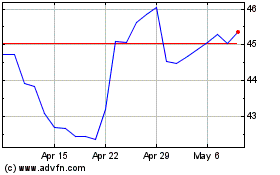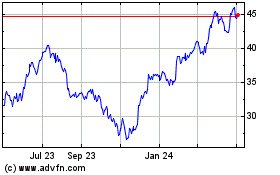By Eric Morath
WASHINGTON -- U.S. employers hired at a solid clip in October,
the latest evidence that the economy remains firmly in growth
mode.
Employment grew by a seasonally adjusted 128,000 in October and
job creation the prior two months was revised higher by 95,000, the
Labor Department reported Friday. Last month, private-sector
employers added jobs, including in health care and hospitality. The
gains more than offset the impact of a strike at General Motors
plants and drop in federal government jobs related to the
Census.
The unemployment rate ticked up from a 50-year low to 3.6% in
October, and wage growth remained steady, up 3% from a year
earlier. Friday's jobs report along with other recent economic news
point to an economy that is growing at a stable but slower rate
compared with 2018, despite signs of a global economic
slowdown.
U.S. employers overall have added to payrolls for 109 straight
months, by far the longest stretch of consistent job creation on
record to 1939. Stocks climbed Friday after the October jobs
figures comforted investors about U.S. growth.
"The labor market is resilient," said Julia Pollak, economist at
job-search site ZipRecuriter. "There's no doubt job growth has been
slower this year, but the difference is small."
October's hiring was consistent with recent trends, after
accounting for two anomalies last month.
Employment in auto manufacturing fell by 41,600 "reflecting
strike activity," according to the Labor Department. The 40-day GM
strike ended last week, but the government didn't count those
workers as on payrolls last month because they were on picket lines
the week of the employer survey. The federal government shed 17,000
jobs because many temporary workers completed their jobs for the
2020 census. Census is planning to add a half-million temporary
jobs next year.
Still, job creation has cooled this year, though it is
consistent with an economy that has settled back to a 2% growth
rate from one expanding last year at about 3%. Employers have added
an average 167,000 jobs to payrolls each month this year. That is a
slowdown from the 223,000 jobs added each month, on average, last
year, and on pace to be the worst year for job creation since
2010.
Job growth remains strong in areas of the economy that serve
U.S. consumers and are generally shielded for global trends and
trade disputes.
The health-care and social-services sector added 34,200 jobs in
October, business services added 22,000 and hospitality, including
restaurants, added 61,000.
With the unemployment rate low and the economy in a decadelong
expansion, diners are as hungry as ever for tacos, said Michael
Mabry, chief development officer as Fuzzy's Taco Shops, a Fort
Worth, Texas, chain of 150 restaurants in 17 states. The company is
planning to add between 15 and 20 locations by the end of next
year, an expansion that would create several hundred new jobs, Mr.
Mabry said.
"The industry itself is stable and our company is having some
pretty good months, so it's stacking up to be a pretty good year,"
he said. Mr. Mabry said finding and retaining workers can be
challenging. The firm's restaurants are trying to become more
efficient by redesigning kitchens to reduce the number of prep
cooks and combining bartender and cashier jobs during slower
periods of the day, he added.
The Federal Reserve this week cut its benchmark interest rate
for the third time since July in an attempt to stimulate the
economy, and signaled it was done cutting rates unless it sees a
significant slowdown in economic activity. Friday's jobs numbers
offer justification for that pause.
Some U.S. employers are acting cautiously.
Melissa Ball, owner of Ball Office Products, isn't cutting
staff, but she also isn't aiming to add workers to her 30-person
company in Richmond, Va.
"We have a good sense of comfort right now but not a lot of
long-term security," she said. Tariffs led to higher prices for
some products, she said. But more generally, Ms. Ball said she is
preparing for a slowdown after some strong years. "I'm not going to
hire someone that I don't feel really confident about their
employment prospects with us for a long time."
The unemployment rate last month rose in part because more
Americans joined the labor force, a positive sign. The rate,
determined by a separate survey of households, was less affected by
the GM strike because GM workers would likely have been counted as
employed but not reporting due to a labor dispute. The two surveys
use different definitions to count employment.
The share of Americans working or searching for work last month
rose to 63.3% from 63.2% in September. The rate rose last month to
the highest level since August 2013, hinting the labor market is
drawing some Americans off the sidelines. Participation among those
in their prime working years, between 25 and 54, touched a 10-year
high.
A broader measure of unemployment and underemployment -- which
includes those too discouraged to look for work, plus Americans
stuck in part-time jobs but who want to work full-time -- rose to
7.0% in October from 6.9% in September.
Wage growth has largely plateaued despite a low unemployment
rate, suggesting workers are in short supply. Average hourly
earnings for private-sector workers increased 6 cents to $28.18 an
hour.
Wages last year accelerated to grow at better than a 3% rate
from a year earlier for the first time in a decade. But since
peaking at a 3.4% increase in February, pay increases have eased
somewhat. That suggests while businesses have job openings, many
businesses are reluctant to boost wages enough to poach workers
from competitors.
Write to Eric Morath at eric.morath@wsj.com
(END) Dow Jones Newswires
November 01, 2019 11:51 ET (15:51 GMT)
Copyright (c) 2019 Dow Jones & Company, Inc.
General Motors (NYSE:GM)
Historical Stock Chart
From Mar 2024 to Apr 2024

General Motors (NYSE:GM)
Historical Stock Chart
From Apr 2023 to Apr 2024
